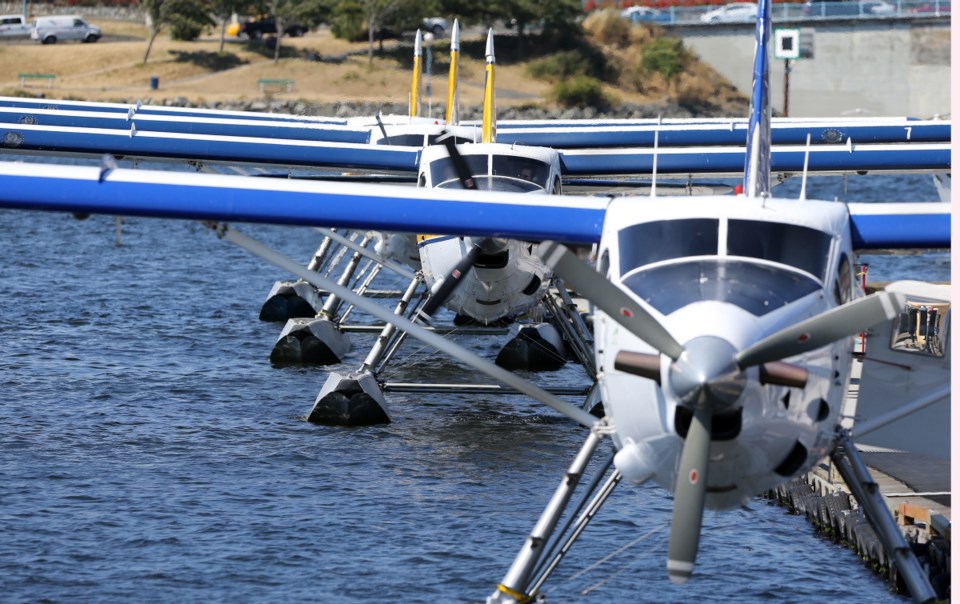Victoria Harbour’s water-based airport — now on the lookout for a new operator — is not a profit-making enterprise, says the chief executive of the Greater Victoria Harbour Authority.
The federally operated aerodrome is running on a “negative business case,” Curtis Grad said.
Its “business model today is a pure cost model,” Grad said. “There is no cost recovery per se coming in from the harbour master function.”
As part of Transport Canada, the harbour master manages both the air and marine systems in the active and diverse harbour.
Transport Canada wants to transfer the operations part of the aerodrome to a local body. The offer continues the federal department’s push to act a regulator only, not operator, of the nation’s airports. It ties in with the direction of the International Civil Aviation Organization to separate those two roles, said Grad, who has spent the majority of his working life in airport management.
It is unknown what it costs to run the harbour airport, or what revenue it may bring in. It is also unknown how any new operation might be structured, or whether the federal government will chip in any money. Transport Canada officials will not comment on financial aspects of the operation despite repeated requests from the Times Colonist.
After being approached by Transport Canada, Victoria councillors agreed last week to ask it for detailed information on running the airport. No decision has been made.
Grad doesn’t know specific aerodrome costs, but said “the vast majority of traffic coming in and out of the harbour, whether it’s a boat or an airplane, are not charged by Transport Canada for utilizing the runway or the navigable water.”
The harbour airport is like a public highway, Grad said. “It’s like the ferry service. It provides a linkage to the mainland and it is a public utility. I think that has to be put in people’s minds, that we shouldn’t be expecting a positive business case on something like this.”
B.C. Ferries receives an annual federal-provincial subsidy. That amount totalled $28 million for the year ending March 31, 2013. The federal subsidy is passed on to B.C. Ferries through the province.
Grad cautioned against new or higher fees for harbour users. “Anything that adds cost to the model is going to create difficulty, both for vessels and aircraft,” he said.
Thousands of aircraft takeoffs and landings happen at the harbour every year. The private sector operates aircraft, ferries running in and out of the harbour, rents vessels to paddlers, and offers fishing charters and whale-watching tours.
The harbour airport is a vastly different operation from the land-based Victoria Airport Authority, which runs Victoria International Airport and pays annual rent under a long-term lease to Transport Canada after an operations transfer in the late 1990s. The harbour airport has few capital assets and does not have the same opportunity for on-land expansion and revenue generation that is available to the Saanich Peninsula facility.
Victoria’s water-based airport is “absolutely critical to the linkage to Vancouver and to the health of the local economy,” Grad said. “So, whoever is going to take it on needs to do it well and needs to do it cost-effectively.”
The harbour authority is not jumping to the front of the line to win the operations job, he said.
“I want to be clear. We are not putting our hands up to take this on. If we are asked to take a look at it, we will. But we will be asking some very critical questions and trying to understand fully what the rules are and what the conditions of such an operation might be,” said Grad.
The harbour airport has been running for 12 years under draft regulations. Those need to be adopted by the federal government to ensure rules and regulations are “crystal-clear” to whoever ends up managing the airport, Grad said.
As a regulator only, Transport Canada will be “increasingly vigilant,” he added.
If the marine and air operations are split up, there would be some duplication of costs, Grad said. If a single operation is in place, like it is today, there would be a transfer of the current costs to the new operator.
Another consideration is the cost of airport insurance, which can be expensive to obtain and maintain, Grad said.
Whoever takes over the airport would also be responsible for dealing with the many interests around the harbour, such as ongoing citizen concerns about fumes and noise from float planes.
“A local operator is going to be much, much more accountable to the concerns of the residents,” Grad said. Stakeholder engagement is “something that is going to take up a tremendous amount of time and energy for whoever takes this on.”
Grad endorses the idea of a locally run harbour airport. “The really important thing is, there is at last an opportunity to have the water aerodrome locally owned and operated,” he said.
“Now, who ends up doing that is a separate question. If we end up working at cross purposes to each other, that is not going to be productive. We need to work together to make this happen. It is not necessarily one party that is going to have to carry the discussion, I think we all have to.”



